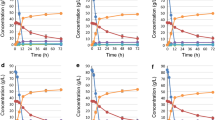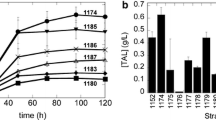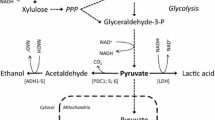Abstract
Supplementation of a chemically defined medium with amino acids or succinate to improve heterologous xylanase production by a prototrophic Saccharomyces cerevisiae transformant was investigated. The corresponding xylanase production during growth on ethanol in batch culture and in glucose-limited chemostat culture were quantified, as the native ADH2 promoter regulating xylanase expression was derepressed under these conditions. The addition of a balanced mixture of the preferred amino acids, Ala, Arg, Asn, Glu, Gln and Gly, improved both biomass and xylanase production, whereas several other individual amino acids inhibited biomass and/or xylanase production. Heterologous protein production by the recombinant yeast was also improved by supplementing the medium with succinate. The production of heterologous xylanase during growth on ethanol or glucose could thus be improved by supplementing metabolic precursors in the carbon- or nitrogen-metabolism.


Similar content being viewed by others
References
Adams MR, Bryan JJ, Thurston PJ (1989) A medium designed for monitoring pitching yeast contamination in beer using a conductimetric technique. Lett Appl Microbiol 8:55–58
Albers E, Larsson C, Lidén G, Niklasson C, Gustafsson L (1996) Influence of nitrogen source on Saccharomyces cerevisiae anaerobic growth and product formation. Appl Environ Microbiol 62:3187–3195
Bailey MJ, Biely P, Poutanen K (1992) Interlaboratory testing of methods for assay of xylanase activity. J Biotechnol 23:257–270
Barkholt V, Jensen AL (1989) Amino acid analysis determination of cysteine plus half-cysteine in proteins after hydrochloric acid hydrolysis with a disulfide compound as additive. Anal Biochem 177:318–322
Blechl AE, Thrasher KS, Vensel WH, Greene FC (1992) Purification and characterization of wheat α-gliadin synthesized in the yeast Saccharomyces cerevisiae. Gene 116:119–127
Boze H, Celine L, Patrick C, Fabien R, Christine V, Yves C, Guy M (2001) High-level secretory production of recombinant porcine follicle-stimulating hormone by Pichia pastoris. Process Biochem 36:907–913
Cha HJ, Kim M-H, Kim SH, Yeo JS, Chae HJ, Yoo YJ (1998) Enhancement, by succinate addition, of the production of cloned glucoamylase from recombinant yeast using a SUC2 promoter. Process Biochem 33:257–261
Chen Y, Kirk N, Piper PW (1993) Effects of medium composition on MFα1 promoter-directed secretion of a small protease inhibitor in Saccharomyces cerevisiae batch fermentation. Biotechnol Lett 15:223–228
Choi W-A, Oh GH, Kang HA, Chung BH (2000) Improvement of intact human lipocortin-I production in Saccharomyces cerevisiae by inhibiting proteolysis. J Biosci Bioeng 89:77–80
Chung BH, Park KS (1998) Simple approach to reducing proteolysis during secretory production of human parathyroid hormone in Saccharomyces cerevisiae. Biotechnol Bioeng 57:245–249
Cooper TG (1982) Nitrogen metabolism in Saccharomyces cerevisiae. In Strathern JN, Jones EW, Broach JR (eds), The molecular and cellular biology of the yeast Saccharomyces. Cold Spring Harbour Laboratory, pp 39–100
Coppella SJ, Dhurjati P (1989) α-Factor directed expression of the human epidermal growth factor in Saccharomyces cerevisiae. Biotechnol Bioeng 33:976–983
Donald KAG, Carle A, Gibbs MD, Bergquist PL (1994) Production of a bacterial thermophilic xylanase in Saccharomyces cerevisiae. Appl Microbiol Biotechnol 42:309–312
Dubois E, Messenguy F (1997) Integration of the multiple controls regulating the expression of the arginase gene CAR1 of Saccharomyces cerevisiae in response to different nitrogen signals: role of Gln3p, ArgRp-Mcm1p, and Ume6p. Mol Gen Genet 253:568–580
Du Preez JC, Mare JE, Albertyn J, Kilian SG (2001) Transcriptional repression of ADH2-regulated β-xylanase production by ethanol in recombinant strains of Saccharomyces cerevisiae. FEMS Yeast Res 1:233–240
Goodrick JC, Xu M, Finnegan R, Schilling BM, Schiavi S, Hoppe H, Wan NC (2001) High-level expression and stabilization of recombinant human chitinase produced in a continuous constitutive Pichia pastoris expression system. Biotechnol Bioeng 74:492–497
Görgens JF, Van Zyl WH, Knoetze JH, Hahn-Hägerdal B (2001) The metabolic burden of the PGK1 and ADH2 promoter systems for heterologous xylanase production by Saccharomyces cerevisiae in defined medium. Biotechnol Bioeng 73:238–245
Görgens JF, Planas J, van Zyl WH, Knoetze JH, Hahn-Hägerdal B (2004) Comparison of three expression systems for heterologous xylanase production by S. cerevisiae in defined medium. Yeast 21:1205–1217
Greasham RL, Herber WK (1997) Design and optimization of growth media. In: Rhodes, PM, Stanbury PF (eds) Applied microbial physiology—a practical approach. Oxford University Press, Oxford, pp 53–74
Grenson M (1992) Amino acid transporters in yeast: structure, function and regulation. In: Molecular aspects of transport proteins. Elsevier, Amsterdam, pp 219–245
Gu MB, Park MH, Kim D-I (1991) Growth rate control in fed-batch cultures of recombinant Saccharomyces cerevisiae producing hepatitis B surface antigen (HBsAg). Appl Microbiol Biotechnol 35:46–50
Herraiz T, Ough CS (1993) Formation of ethyl esters of amino acids by yeasts during the alcoholic fermentation of grape juice. Am J Enol Viticul 44:41–48
Horák J (1997) Yeast nutrient transporters. Biochim Biophys Acta 1331:41–79
Jin S, Ye K, Shimizu K (1997) Metabolic flux distributions in recombinant Saccharomyces cerevisiae during foreign protein production. J Biotechnol 54:161–174
Jiranek V, Langridge P, Henschke PA (1995) Amino acid and ammonium utilization by Saccharomyces cerevisiae wine yeasts from a chemically defined medium. Am J Enol Vitic 46:75–83
Jones EW (1991) Tackling the protease problem in Saccharomyces cerevisiae. In: Guthrie C, Fink GR (eds) Methods in enzymology, guide to yeast genetics and molecular biology, vol 194. Academic Press, San Diego, pp 428–452
Kaclikova E, Lachowicz TM, Gbelska Y, Subik J (1992) Fumaric acid overproduction in yeast mutants deficient in fumarase. FEMS Microbiol Lett 91:101–106
Kang HA, Choi E-S, Hong W-K, Kim J-Y, Ko S-M, Sohn J-H, Rhee SK (2000) Proteolytic stability of recombinant humans serum albumin secreted in the yeast Saccharomyces cerevisiae. Appl Microbiol Biotechnol 53:575–582
La Grange DC, Pretorius IS, Van Zyl WH (1996) Expression of a Trichoderma reesei β-xylanase gene (XYN2) in Saccharomyces cerevisiae. Appl Environ Microbiol 62:1036–1044
Mendoza-Vega O, Sabatie J, Brown SW (1994) Industrial production of heterologous proteins by fed-batch cultures of the yeast Saccharomyces cerevisiae. FEMS Microbiol Rev 15:369–410
Messenguy F, Colin D, Ten Have J-P (1980) Regulation of compartmentalisation of amino acid pools in Saccharomyces cerevisiae and its effects on metabolic control. Eur J Biochem 108:439–447
Miller GL, Blum R, Glennon WE, Burton AL (1960) Measurement of carboxymethylcellulase activity. Anal Biochem 2:127–132
Nuyens F, Van Zyl WH, Iserentant D, Verachtert H, Michiels C (2001) Heterologous expression of the Bacillus pumilus endo-β-xylanase (xynA) gene in the yeast Saccharomyces cerevisiae. Appl Microbiol Biotechnol 56:431–434
Ogrydziak DM (1993) Yeast extracellular proteases. Crit Rev Biotechnol 13: 1–55
Pérez-González JA, De Graaff LH, Visser J, Ramón D (1996) Molecular cloning and expression in Saccharomyces cerevisiae of two Aspergillus nidulans xylanase genes. Appl Environ Microbiol 62:2179–2182
Rothstein R (1991) Targeting, disruption, replacement, and allele rescue: integrative DNA transformation in yeast. In: Guthrie C, Fink GR (eds) Methods in enzymology, guide to yeast genetics and molecular biology, vol 194. Academic Press, San Diego, pp 302–318
Slaughter JC, McKernan G, Saita M (1990) Intracellular asparagine pool as a factor in control of ammonium uptake by Saccharomyces cerevisiae. Mycol Res 94:1009–1012
Sreekrishna K, Brankamp RG, Kropp KE, Blankenship DT, Tsay J-T, Smith PL, Wierschke JD, Subramaniam A, Birkenberger LA (1997) Strategies for optimal synthesis and secretion of heterologous proteins in methylotropic yeast Pichia pastoris. Gene 190:55–62
Ter Schure EG, Van Riel NAW, Verrips CT (2000) The role of ammonia metabolism in nitrogen catabolite repression in Saccharomyces cerevisiae. FEMS Microbiol Rev 24:67–83
Thomas KC, Ingledew WM (1990) Fuel alcohol production: effects of free amino nitrogen on fermentation of very-high-gravity wheat mashes. Appl Environ Microbiol 56:2046–2050
Thomas KC, Ingledew WM (1992) Relationship of low lysine and high arginine concentrations to efficient ethanolic fermentation of wheat mashes. Can J Microbiol 38:626–634
Toman PD, Chisholm G, McMullin H, Giere LM, Olsen DR, Kovach RJ, Leigh SD, Fong BE, Chang R, Daniels GA, Berg RA, Hitzeman RA (2000) Production of recombinant human type I procollagen trimers using a four-gene expression system in the yeast Saccharomyces cerevisiae. J Biol Chem 275:23303–23309
Verduyn C, Postma E, Scheffers WA, Van Dijken JP (1992) Effect of benzoic acid metabolism on metabolic fluxes in yeast: a continuous culture study on the regulation of respiration and alcoholic fermentation. Yeast 8:501–507
Werten MWT, Van den Bosch TJ, Wind RD, Mooibroek H, De Wolf FA (1999) High-yield secretion of recombinant gelatins by Pichia pastoris. Yeast 15:1087–1096
Wiame J-M, Grenson M, Arst HN (1985) Nitrogen catabolite repression in yeasts and filamentous fungi. Adv Microb Phys 26:1–88
Wittrup KD, Benig V (1994) Optimisation of amino acid supplements for heterologous protein secretion in Saccharomyces cerevisiae. Biotechnol Tech 8:161–166
Acknowledgements
Ms Jenny Ågren (Lund University) and Mr Henk Blignault (Stellenbosch University) are gratefully acknowledged for technical assistance during screening of the medium components.
Author information
Authors and Affiliations
Corresponding author
Rights and permissions
About this article
Cite this article
Görgens, J.F., van Zyl, W.H., Knoetze, J.H. et al. Amino acid supplementation improves heterologous protein production by Saccharomyces cerevisiae in defined medium. Appl Microbiol Biotechnol 67, 684–691 (2005). https://doi.org/10.1007/s00253-004-1803-3
Received:
Revised:
Accepted:
Published:
Issue Date:
DOI: https://doi.org/10.1007/s00253-004-1803-3




